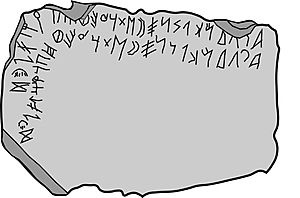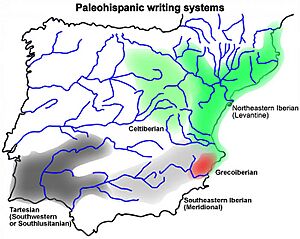Espanca script facts for kids
The Espanca script is a very old writing system found in Castro Verde, a town in southern Portugal. It's special because it was the first "signary" (which means an alphabet or list of letters) discovered from a group of ancient writings called Paleohispanic scripts. This important discovery was found on a piece of slate rock, which is about the size of a laptop (48 by 28 centimeters and 2 centimeters thick).
What makes the Espanca script really interesting is that it has 27 letters written twice! It looks like someone wrote the alphabet once neatly, and then someone else copied it, but not as well. Experts think this slate was probably used as a teaching tool, where a teacher wrote the letters and a student practiced copying them.
How the Espanca Script Connects to Other Alphabets
The Espanca alphabet doesn't exactly match any other known Paleohispanic scripts. However, it is clearly related to the southwestern Tartessian script and the southeastern Iberian script. This shows how different ancient writing systems can be connected.
The first 13 letters of the Espanca script are very similar to letters from the 22-letter Phoenician alphabet. They look alike and are in the same order. The Phoenician alphabet was one of the earliest alphabets and influenced many others.
The rest of the Espanca letters include other Phoenician letters, but they are a bit out of order. Plus, there are five extra letters that seem to have been created specifically for the Paleohispanic scripts. This mix of old and new letters makes the Espanca script very interesting for historians and linguists.
Other Similar Ancient Discoveries
For a long time, the Espanca signary was the only Paleohispanic alphabet known. But in recent years, archaeologists have found four more similar signaries! These include the Castellet de Bernabé signary, the Tos Pelat signary, the Ger signary, and the Bolvir signary.
Each of these new discoveries has its own unique sequence of signs. None of them match the exact order of letters found in the Espanca signary. This shows that ancient people in different areas might have arranged their alphabets in slightly different ways.
Recently, in May 2023, another important discovery was made. An inscription on a piece of pottery called an ostrakon was found in Villasviejas del Tamuja, Spain. This inscription seems to be a southern Paleohispanic alphabet. It matches seven signs from the middle part of the Espanca alphabet. These new finds help us learn more about how ancient writing developed.
See also
 In Spanish: Escritura de Espanca para niños
In Spanish: Escritura de Espanca para niños
- Pre-Roman peoples of the Iberian Peninsula
- Paleohispanic scripts



